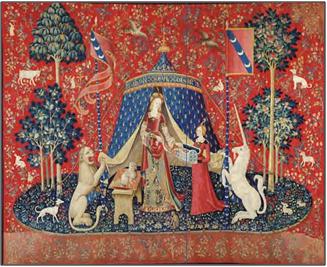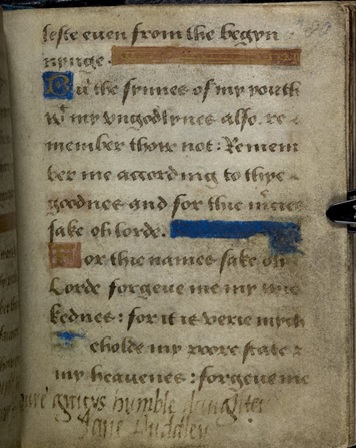Another item has been added to the Items section of the website.
Did’Romance of the Saint Graal’ belong to Lady Jane?
Another item has been added to the Items section of the website.
Did’Romance of the Saint Graal’ belong to Lady Jane?
Leanda de Lisle has written a guest article over at One The Tudor Trail.
Arthur Tudor & Katherine of Aragon – Was their Marriage Consummated?
The ‘Elizabeth I & Her People’ exhibition at the National Portrait Gallery is a must see. Not only are there wonderful portraits on display but there also some very interesting objects as well.
‘This exhibition explores the story of the Elizabethans from the Queen, the nobility and gentry to many other talented individuals such as explorers, soldiers, merchants, artists and writers.’ (NPG website)
‘The exhibition includes many outstanding paintings of Elizabeth I and her courtiers including explorers and soldiers, and enchanting portraits of her female attendants. Visitors will also come face-to-face with lesser-known Elizabethans including butchers, goldsmiths, brewers, merchants, writes and artists. These will be shown alongside artefacts from the period including exquisite jewellery, books and coins, which give a fascinating glimpse into their way of life.’ (NPG leaflet)
My favourite item was the sweet box that either belonged to or was made for Robert Dudley to give away.
Sweet box either belonging to or given by Robert Dudley
Decorative sweet box
Iron, damascened with gold & silver
1579
You can read more about ‘The Dudley Box’ at the V&A website.
Other highlights included:
Elizabeth I: The Ermine Portrait
Nicholas Hilliard
1585
Two portraits on loan from Hardwick Hall.
Bess of Hardwick
Follower of Hans Eworth
1560
Hardwick Hall portrait of Queen Elizabeth
Unknown artist
1598-9
Memento mori ring (death’s head ring)
1550-1600
Gold, enamel
Inscribed at front of bezel + BE HOLD THE ENDE
Around the edge of bezel RATHER DEATH THAN FAILS FAYTH
According to Leanda de Lisle, Katherine (Jane’s sister), wore this type of ring.
In ‘The Sisters Who Would Be Queen’ de Lisle writes that as Katherine Seymour lay dying, she asked Sir Owen Hopton to ‘deliver a few tokens to her husband.’ Amongst these tokens was a ‘ring mounted with a death’s head. Such rings, known as a memento mori, were intended as a reminder to the wearer of their mortality. ‘This shall be the last token unto my Lord that I shall ever send him. It is a picture of myself’, she said.’ (p.269-270, de Lisle)
You can read more about the ring at the V&A website.
A Fete at Bermondsey
Joris Hoefnagel
1568-70
This painting has a view of the Tower of London in the background and you can buy a copy at the exhibition gift shop.
Elizabeth Vernon (Countess of Southampton)
c1600
Unknown artist
In the background of this portrait on the table are dress pins. You can see the real thing in a display case near by.
William Cecil’s tankard
c1575
Silver-gilt, enamel & glass
Embroidered panel with the Hardwick crest (a stag) with the initials ES
1559-64/5
John Day
Unknown artist
1562
Woodcut
De Lisle describes how Jane’s letters (to Thomas Harding and her sister, Katherine) and ‘a description of Jane’s conversation in the Tower with Feckenham’ had been sent ‘to an evangelical printer in Lincolnshire called John Day’ and that ‘Day’s press was hidden on the estate of…Sir William Cecil.’ (p.159, de Lisle)
Professor Eric Ives writes that, ‘In 1554 there appeared ‘An Epistle of the Ladye Jane, a righte virtuous woman to a learned man of late falne from the truth’, conjecturally from the press of John Day, a prolific Protestant printer who in October 1554 was arrested on suspicion of publishing material hostile to the Marian regime.’ (p.21, Ives)
What makes this exhibition come alive are the objects on display. You half expect Elizabeth and Robert Dudley to come down from their paintings and for him to offer her a sweet, for Cecil to climb off his mule and drink from his tankard, Bess of Hardwick to take up her embroidery and for Elizabeth Vernon take the pins from the display case and finish dressing.
* All italic item text is (c) National Portrait Gallery.
The exhibition runs until 5 January 2014.
You can buy tickets from the National Portrait Gallery website:
National Portrait Gallery – Tickets
Sources
Elizabeth I & Her People – National Portrait Gallery
Elizabeth I & Her People Leaflet – National Portrait Gallery
Ives, E. (2009) Lady Jane Grey: A Tudor Mystery, Wiley-Blackwell.
De Lisle, L. (2010) The Sisters Who Would Be Queen: The Tragedy of Mary, Katherine and Lady Jane Grey, HarperPress.
Helen Castor’s new series ‘Medieval Lives’ concludes tonight at 9pm on BBC4.
According to her website, ‘this exploration of the medieval experience of life’s great rites of passage includes stories of the 15th-century Paston family, as told in Helen’s book BLOOD & ROSES.’ (Helen Castor.com)
The final episode of this three part series looks at death.
This is what the press has to say:
‘Most of the time we try not to think about death, but the people of the Middle Ages didn’t have that luxury. Death was always close at hand, for young and old, rich and poor – even before the horrors of the Black Death, which killed millions in a few short months.
However, for the people of the Middle Ages death wasn’t an end but a doorway to everlasting life. The Church taught that an eternity spent in heaven or hell was much more important than this life’s fleeting achievements and there was much you could do to prepare for the next life in this one.
As historian Helen Castor reveals, how to be remembered – and remembering your loved ones – shaped not only the worship of the people of the Middle Ages but the very buildings and funding of the medieval Church itself.’
(BBC4 website)
‘In the final episode, Dr Helen Castor sheds light on how the Catholic church shaped medieval folk’s desire for a “good death”.
In the 13th century, the Pope formally adopted the concept of purgatory: a dimension characterised by “darkness, fire and terror”, which seems to have held great prominence within the medieval collective consciousness. The best way to curtail your stay there was to leave behind money for masses; effectively, the rich could buy their way out of purgatory by paying bribes to the church. Henry VII, for example, left sufficient funding for 10,000 masses to be said immediately after his death, to give his soul a turbo-charged route to heaven.
This is a striking insight into a very different world, but Dr Castor plays it straight down the line; you won’t find gimmicky gothic cemeteries or creaking mausoleum doors here.
Historian Helen Castor explores how mortality was perceived in the Middle Ages, revealing that people looked upon death as a beginning rather than an ending – a doorway to everlasting life. The prospect of reaching Heaven and being remembered in a good light shaped not only people’s behaviour, but also the buildings and funding of the Church itself.’
(Gary Rose, Radio Times website)
You can view a clip here:
BBC4 – Medieval Lives: A Good Death
Episode 3 – A Good Death will be repeated:
BBC 4
Thursday 24 October – 03.00
Sunday 27 October – 23.00
Sources
Christ Church College, Oxford have asked me to mention their special interest event that Helen Castor will be speaking at next year.
‘Politics, Patronage and Prostitution: The Experiences of Medieval Women’ runs from 3-6 April 2014.
From the Christ Church website:
‘Every Spring Christ Church holds a Special Interest Weekend open to the public. In April 2014 we are having a single topic weekend on ‘Politics, Patronage and Prostitution: The Experiences of Medieval Women’. This weekend offers the chance to hear papers from a group of specialists on those matters which involved and concerned women generally. By sampling some individuals, such as Christine de Pisan, Heloise, Eleanor of Aquitaine and Joan of Arc, as well as taking a look at the experiences of those less famous, we shall endeavour to answer the question: what was it like for women to live in the medieval world?’
Speakers include:
Dr Rowena E. Archer
Christine de Pisan (c.1364-c.1430) and Other Sources on the Lives of Medieval Women
Dr Frederik Pedersen
Tying the Knot: Love, Law and Marriage in the Middle Ages
Dr Helen Castor
She-Wolves: Queens and Power in Medieval England
Dr Hugh Doherty
Eleanor of Aquitaine (1122-1204): Duchess, Crusader, Queen
Dr Francis Woodman
Medieval Women as Patrons of Architecture

The Lady and the Unicorn
(c) Musee National de Moyen Age et des Thermes de Cluny, Paris & The Bridgeman Art Library
Professor Caroline Barron
Was There a “Golden Age” for Women in Medieval London?
Dr Martin Ingram
Common Women, Public Good? : Prostitutes and Society in Later Medieval England
Henrietta Leyser
Kiss and Tell? Abelard and Heloise Revisited
Dr Hannah Skoda
Warrior, Visionary or Heretic? : Trying to Understand Joan of Arc
Dr Maria Hayward
Power Dressing in the Middle Ages: How Women Used Clothing to Assert Their Position in Society
You can download the brochure:
Politics, Patronage and Prostitution: The Experiences of Medieval Women Brochure
For cost details and how to book:
You can either book online at:
Christ Church Oxford – Special Interest Event
Or phone:
+44 (0)1865 286848
Further details
Please direct all enquiries to:
Special Interest Weekend
The Steward’s Office
Christ Church
Oxford, OX1 1DP
Email: specialinterest@chch.ox.ac.uk
Web: www.chch.ox.ac.uk
Sources
Christ Church Oxford – Special Interest Weekend
* All images from the Politics, Patronage and Prostitution: The Experiences of Medieval Women brochure
The British Library
The Bridgeman Art Library
Fontevrault Abbey
